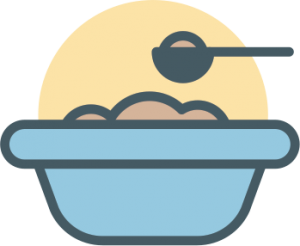Tips for Getting Started
 Complementary foods (foods other than breast milk or formula) are an important part of the diet for infants that are developmentally ready for them. This includes infant cereal, vegetables, fruits, meat, and other protein-rich foods that have a modified texture (e.g., strained, pureed, chopped, etc.). As the baby’s development progresses, the texture too will progress from strained to chopped or whole pieces. In addition to a variety of flavors, exposure to a variety of textures during complementary feeding will assist with the transition to an adult diet.
Complementary foods (foods other than breast milk or formula) are an important part of the diet for infants that are developmentally ready for them. This includes infant cereal, vegetables, fruits, meat, and other protein-rich foods that have a modified texture (e.g., strained, pureed, chopped, etc.). As the baby’s development progresses, the texture too will progress from strained to chopped or whole pieces. In addition to a variety of flavors, exposure to a variety of textures during complementary feeding will assist with the transition to an adult diet.
First Foods
Start with one “single ingredient” food for 3-5 days to observe the baby’s reaction to that food. If your baby develops a rash, diarrhea or has breathing changes, stop feeding that food to your child. Iron-fortified infant rice cereal is a good first choice because it is easy to digest and the texture is easy to adapt. First foods can be mixed with breast milk or formula to attain a “soupy” texture that is easiest to swallow. At first, touch the spoon with food to your baby’s lips. This gives them a sample of the flavor, and time to decide if they like it. Do not force feed any food to your child; it is not helpful for developing healthy eating habits. If the baby does not like a specific food, you can try it again in a few weeks.
Mealtime Magic
Family meals are social; keep your baby close during meal times. Keep an eye out for your baby’s readiness to advance to complementary foods around 6 months. Keep the meal time atmosphere casual, supportive and relaxed. Here are some additional tips for managing mealtimes:
- Offer a complementary food when both you and your baby are relaxed
- Bring your baby close to the table and sit close to him/her
- Allow your child to explore the food by touching and smelling
- Feed small portions of food after breastmilk or infant formula.
- Watch for cues that show if the baby wants more or is finished (turning head away, shutting mouth)
- It may only take a few offerings before a child accepts a new food, making it a good time to introduce a variety of new flavors and textures since babies are more accepting than preschoolers
- Complementary feeding takes practice; skill development takes time
- Be patient and enjoy every stage of your baby’s progress
- Make mealtimes fun, a time for an infant to explore the food and develop a healthy relationship with eating
References
https://wicworks.fns.usda.gov/sites/default/files/media/document/infant-feeding-guide.pdf
Did you know?
It is the day-to-day experiences (activities like playing, being read to, learning and interacting with people) that helps develop your baby’s brain.
Did you know?
Your baby’s brain at birth weighs 2/3 to 3/4 pounds and contains 100 billion neurons

